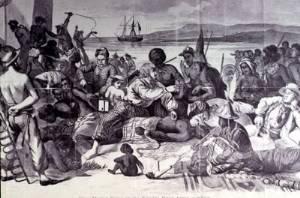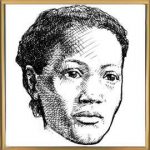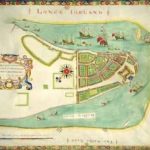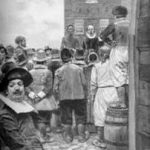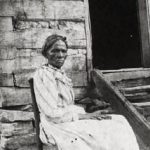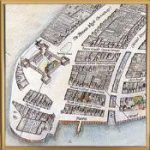Chattel Slavery
Slavery was introduced into the colony of New Jersey in the 17th century, shortly after the Dutch first settled in the colony. The colonial system of slavery was a labor system known as chattel slavery, in which the slave was the personal property of his or her owner for life.
Men and women brought from Africa, either directly or by way of the Caribbean Islands, were enslaved under this system. Children born to slave women were the property of their mother’s owner, and became slaves for life.
The first African slaves were imported to New Jersey by Dutch traders. No early Dutch records of slave sales have survived, but a 1628 letter written by a Dutch minister referred to the Angolans. English traders continued the practice after taking the colony from the Dutch in 1664.
The British Colonial Period
The west bank of the Hudson River was originally part of the Dutch colony of New Netherland, and it faced the same chronic shortage of free labor as the rest of the region. The English proprietors who established the New Jersey colony after defeating the Dutch in 1664 were even more aggressive than the neighboring states in encouraging African slavery as a means to open up the land for agriculture and commerce.
Early laws of the colony encouraged settlers to import slaves for labor by headrights, an award of 60 acres of land for every slave brought into the colony. The first African slaves to appear in English records were owned by Colonel Lewis Morris in Shrewsbury, Monmouth County.
But while slaves were encouraged, free blacks were not. Free blacks were barred by law from owning land in colonial New Jersey.
In 1702, when New Jersey became a crown colony, Governor Edward Cornbury was dispatched from London with instructions to keep the settlers provided with “a constant and sufficient supply of merchantable Negroes at moderate prices.” He likewise was ordered to assist slave traders and “to take especial care that payment be duly made.”
New Jersey Slave Laws
Although enslavement in New Jersey was somewhat benign during the Dutch period, it changed during the British era into a more oppressive system, especially in eastern New Jersey. Slaves were not allowed to carry firearms, meet with other slaves, walk the streets at night, or hunt unless accompanied by their masters.
In 1713 (after a violent slave uprising in New York), special laws were enacted to control the actions of slaves, and the colony began to operate a separate court system to deal with slave crimes.
Laws were passed to discourage slave revolts. Slaves were forbidden to carry firearms when not in the company of their masters, and anyone who gave or lent a gun to a slave faced a fine of 20 shillings. Slaves could not assemble on their own or be in the streets at night. Controls were further tightened during times of crisis.
Slaves guilty of arson were to be put to death in a way that “the aggravation or enormity of their crime shall merit and require.” In 1735, a slave in Bergen County who attempted to set fire to a house was burned at the stake. Six years later, authorities in Hackensack burned at the stake two slaves who had been setting fire to barns.
In spite of these precautions, New Jersey narrowly escaped a slave insurrection in 1743. Word spread among slaves in Burlington County that England had outlawed slavery, and that they were being held in bondage illegally. At midnight on a certain date the slaves agreed to slit the throats of their masters, capture the women, plunder the farms, and escape to the French and Indians.
A slave let word of the plot slip during an argument with a white man, the authorities were alerted, and after an investigation 30 ringleaders were arrested. Because the plot had not been carried out, only one man was hanged. The rest were sentenced to be flogged or to have their ears cut off.
During Queen Anne’s War (1702-1713), any slave found more than five miles from home without a pass was to be flogged, and the master was required to pay a reward to the person who had reported the infraction. Harsh punishments for slaves remained on the books until 1788.
The Slave Population
In 1680, there were about 120 black slaves in New Jersey, sixty or seventy of those at a plantation in Shrewsbury, Monmouth County. The remainder were working in an iron mill at Tinton Falls, Monmouth County.
From 2,581 in 1726, New Jersey’s slave population grew to nearly 4,000 in 1738. A 1745 census showed that 74 percent of the slaves in the colony lived in 5 eastern counties, even though these were not the most populous counties in New Jersey.
In 1790, the census recorded 11,423 slaves, 6.2% of the total population of 184,139. By 1800 there were an estimated 12,422 enslaved men and women in New Jersey, or 5.8 percent of the population.
In the decades before the Revolution, slaves were numerous near Perth Amboy, a major point of entry, and the eastern counties. Slaves were used for labor in areas of agriculture, including South Jersey, but they also filled skilled artisan jobs in shipyards and industry in coastal cities.
Revolutionary Era
During the 18th century, especially during the Revolutionary era, the contrast between the institution of slavery and the principles of human rights endorsed by New Jersey patriots and Quakers resulted in outspoken opposition to slavery. Attempts were made to cause the colonial legislature to end the slave trade.
Despite the service of slaves in military forces and their work on the home front during the Revolutionary War, the New Jersey Constitution of 1776 did not abolish slavery. New Jersey and New York were the only northern states that did not move to limit slavery during the War.
Emancipation
Some steps were taken by the legislature during the late 18th century to improve the condition of slaves, but it was not until 1804 that the New Jersey legislature passed the Act for the Gradual Emancipation of Slavery. Under this act, children born to an enslaved woman after July 4, 1804, were free, but the law also stated that female children were obligated to serve their mother’s owner until the age of 21, and male children were obligated until the age of 25.
If an owner did not wish to enforce this obligation, he or she could abandon the infant to the local overseers of the poor when it was one year old and be relieved of its care. People who were born into slavery before July 4, 1804, were slaves for life unless their owners chose to free them.
New Jersey, like other northern states, replaced outright slavery with stricter controls of free blacks. Blacks lost the right to vote an 1807, when a state law identified eligible voters as “free, white male” citizens.
In 1830, of the 3,568 Northern blacks who remained slaves, more than two-thirds were in New Jersey. The institution was rapidly declining in the 1830s, but was not permanently abolished until 1846.
SOURCES
Slavery in the North
Wikipedia: History of Slavery in New Jersey
